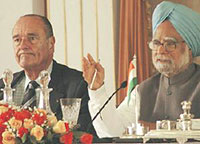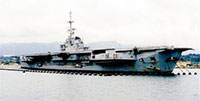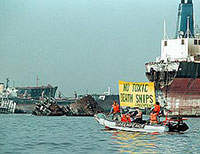Toxic Warship Not Allowed to Disrupt India-France Summit
by Frederick Noronha, Environment News Service
 |
 |
 |
 |
| |
 |
|
| |
From left: President of France, Jacques Chirac, and Prime Minister of India, Dr. Manmohan Singh address at a joint press conference today in New Delhi. (Photo courtesy Government of India) |
|
 |
 |
 |
 |
 |
 |
| |
 |
|
| |
The French aircraft carrier Clemenceau tied up at Toulon, France. (Photo courtesy of the French Navy) |
|
 |
 |
 |
 |
 |
 |
| |
 |
|
| |
Greenpeace has campaigned to cleanup the Alang shipyard for years. This protest was conducted December 8, 1999. (Photo by Santosh Bane courtesy) |
|
 |
 |
 |
 |
 |
 |
| |
 |
|
| |
Workers at Alang shipbreaking yard, January 2001. (Photo by Shailendra Yashwant courtesy Greenpeace) |
|
 |
 |
 |
|
| |
20 February 2006 (New Delhi, India) –
French President Jacques Chirac began a state visit to India Sunday, and today signed bilateral agreements for civilian nuclear cooperation, space, energy and tourism, with military hardware deals expected in the future.
Prime Minister Manmohan Singh called it a "landmark" visit, and said trade between India and France is set to double over five years with "infrastructure, IT, pharmaceuticals, environment, advanced and new technologies, food processing, automobiles and aeronautics as priority sectors for forging business partnerships."
But Chirac's visit was nearly overshadowed by controversy over the Clemenceau, an obsolete French aircraft carrier on its way to India for shipbreaking - until Wednesday.
On February 15, President Chirac ordered the Clemenceau to return to French waters and remain on standby following a ruling by France's highest administrative court, the Conseil d'État. The court acted on a complaint from Greenpeace regarding discrepancies in the amount of asbestos and other toxics present in the ship, which Greenpeace argued would pose a health and environmental hazard in India.
"This is a huge victory for the environment, and for the campaign headed up by us and other organizations," said Greenpeace France executive director Pascal Husting.
Greenpeace demanded that France should deal with its own toxic waste instead of shipping it to India, where workers employed in a poorly managed shipbreaking industry would be exposed to toxic waste.
Husting explained, "We said it was wrong for France to dump a 27,000-ton warship full of asbestos, PCBs, lead, mercury, and other toxic chemicals in India to be broken up by hand in a scrapyard where impoverished workers are injured and die every day. France insisted it was right and sent the ship to India anyway."
Since the Clemenceau was decommmissioned in Toulon, France in 1997 it has been kicked around like a football no one wants.
In 2001, attempts to scuttle the ship as an artificial reef in the Meditarranean failed when environmental authorities said the amount of asbestos onboard was unsuitable for a reef.
In 2003, Turkey refused to accept the ship for shipbreaking, and in addition, a German ship broker was unsuccessful in his attempt to remove visible asbestos from ship in Italy when costs skyrocketed. Greece refused to allow the ship to enter for decontamination.
Then in 2005 an attempt to partly remove visible asbestos in Toulon failed, and French anti-asbestos activists went to court to prevent the Clemenceau from being sent to India for shipbreaking
French courts declared the fate of ship a "military matter," and the French Defence Ministry announced plans to send ship to India.
The Clemenceau was purchased by Shri Ram Vessels situated in the Alang shipbreaking and recycling yard on the Gulf of Cambay in the state of Gujarat not far from the Indian border with Pakistan.
On December 31, 2005 the Clemenceau left the French port of Toulon to be dismantled in Alang.
Two Greenpeace activists boarded the ship during its transit through the Mediterranean towards India. One of them had spent 24 hours on the mast of the Clemenceau in December, trying to prevent it from leaving France.
When the ship reached Egypt on January 12, Egyptian authorities denied access to the Suez Canal, asking for proof that the ship did not violate the Basel Convention on Hazardous Wastes. On January 23, after another Greenpeace boarding to protest the toxic transaction, the ship was allowed to pass.
In India on January 6, the Supreme Court temporarily denied the ship access to Alang, citing the Basel Convention. The Indian Supreme Court was split on the issue and has decided to seek further advice.
Under its monitoring committee on hazardous wastes, the Indian Supreme Court decided on February 13 to constitute a new panel to examine the issue. The court directed the Government of India to suggest by Friday the names of three or four retired Navy officers for appointment to the new panel.
Meanwhile, the French Supreme Court recommended suspension of the ship's transfer to India as European law may have been violated. The Clemenceau is now on its way back to France.
The Indian buyer of the controversial ship has challenged Greenpeace to "come out with facts" to support its claims that breaking of ships containing asbestos at Alang has caused the cancer asbestosis among workers.
Owner of Shri Ram Vessels Mukesh Patel told the Press Trust of India news agency that the environmental group was spreading a "disinformation campaign" to stop the entry of the aircraft carrier.
"I challenge them to prove by giving names and details of workers who have got asbestosis or cancer on account of working in Alang shipyards," he said.
Business interests claim that over 40,000 people depend on Alang's Ship Recycling Yard for their livelihood, saying it has beached nearly 4,200 vessels and has produced three million metric tons of steel.
But Greenpeace has a different view of the shipbreaking yard.
"The case of the Clemenceau has become a symbol of the moral injustice of rich countries dumping their toxic waste on poorer countries. Having tried and failed to offload the ship to other countries to avoid responsibility for the toxic mess of its own making, France has finally been forced to clean up its own act," the group said in a statement.
Greenpeace says that every year "a vast decrepit armada bearing a dangerous cargo of toxic substances, asbestos, PCBs and heavy metals, ends up in ship breaking yards in Bangladesh, India, China, and Pakistan.
Shipbreaking in these areas, the group said, involves ships being "cut up in the crudest of fashions, taking a huge toll on human health and the local environment."
In India, the Asbestos Cement Products Manufacturers' Association based in New Delhi took out large ads in the Indian mainstream media seeking to distance their products from the ship.
The ad reads, "What has the French ship Clemenceau got to do with asbestos cement products? Nothing." It argues that the "recent asbestos scare" created in the public due to the ship is "in no way connected to the use of chrysotile fibre imported in the country."
The Clemenceau possibly contains "high quantities of crocidolite (blue asbestos) and amosite (brown asbestos), both of which are linked to lung diseases such as mesothelioma and asbestosis," the ad admits, but says this bears "no relation" with the use of "chrysotile (white asbestos) in the manufacturing of asbestos cement products by the Indian industry."
In a Joint Statement issued after their meeting today Prime Minister Singh and President Chirac said that as India "embarks on a period of rapid economic development, trade and investment relations with France are becoming more diverse."
"The two governments will make all efforts to increase the volume of investment and joint ventures in each other’s countries and realize the great potential for enhanced business partnerships," the leaders stated.
The two leaders expressed satisfaction at India joining as a full partner the International Thermonuclear Experimental Reactor (ITER) nuclear fusion project.
France and India have also signed an agreement on defense cooperation. "This is an important element of the Strategic Partnership between the two nations," the leaders said in their Joint Statement, "building upon and expanding co-operation in the defense and military fields, defense industry, production, procurement, research and development of defense material, joint exercises, professional exchanges and training."
The final fate of the Clemenceau will indicate how India's shipbreaking industry handles obsolete French military vessels in the future.
FAIR USE NOTICE. This document contains copyrighted material whose use has not been specifically authorized by the copyright owner. The Basel Action Network is making this article available in our efforts to advance understanding of ecological sustainability and environmental justice issues. We believe that this constitutes a 'fair use' of the copyrighted material as provided for in section 107 of the US Copyright Law. If you wish to use this copyrighted material for purposes of your own that go beyond 'fair use', you must obtain permission from the copyright owner.
More News
|